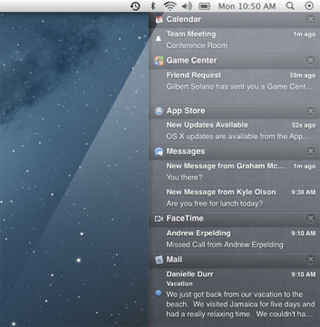In October of 2010, Apple held a media briefing at its Cupertino campus. It called the event Back to the Mac, and one of the key pieces of news was the first public showing of OS X 10.7 Lion, an upgrade to its Mac operating system. Lion was the first version of OS X to reflect the influence of iOS, the software on the iPhone and iPad: It brought a bunch of iOS features “back to the Mac,” including an App Store, a full-screen mode, and FaceTime video chat.
It was a big idea. Too big, it turns out, to fit into one upgrade.
Today, Apple is unveiling OS X 10.8 Mountain Lion, its first major update to the Mac’s software since Lion. As its name suggests, it feels like a continuation of Lion–one that borrows even more features from iOS. It also ties Apple’s two operating systems more tightly together through iCloud, Apple’s service for storing documents and other data on the Net. The overall emphasis on iOS influence and iCloud integration is so overwhelming that Apple could have called this upgrade “Lion Part II” or “Lion iCloud Edition.”
(MORE: With OS X Lion, Apple’s Macs Enter the iPad Era)
As usual with new operating systems, Mountain Lion is getting its first wave of publicity long before it’s ready for consumers to buy. Apple is spilling the beans now because it’s releasing a preview version for developers today. It says it plans to finish the software by the summer, which would let it release the update–via its Mac App Store–roughly a year after Lion shipped in July 2011. That’s a rapid turn-around time by operating-system standards: Lion appeared 23 months after its predecessor, Snow Leopard.
Apple recently briefed me on the new features and loaned me a MacBook Air loaded with a beta version of Mountain Lion. I’ve been test-driving for the past week. It’s a tad glitchy and is missing some features, so it’s too early to render a decisive verdict. But it works well enough that I’m looking forward to getting my hands on the fully-baked version later this year.
The first big thing you’ll notice about Mountain Lion is–well, it’s the fact that you probably won’t instantly notice anything big. Despite the profusion of new features borrowed from iOS, Apple has left the venerable basics of OS X’s user interface pretty much alone, including the desktop, the Dock and windows. (It’s a strikingly different approach from Microsoft’s upcoming Windows 8, which demotes the classic Windows look and feel in favor of a radical new one based on Windows Phone 7’s Metro interface.)
Dig into Apple’s upgrade, however, and you’ll discover new signs of iOS’s influence lurking everywhere.

Apple
None of them are more obvious than Notification Center, a consistent, centralized mechanism for calling your attention to things going on in applications other than the one you’re using. A notification can pop up momentarily in the upper right-hand corner of the screen to remind you about a meeting scheduled in your calendar, for instance, or to alert you to an incoming e-mail or instant message. Swipe with two fingers along the touchpad’s right edge, and you can summon a scrolling list of all the notifications that have been displayed recently. Except for the fact that everything sits on the right hand of the display rather than the top, it’s all very much like the notification system that Apple introduced in iOS5. And it should be particularly useful when you’re working in a program’s full-screen mode and don’t want to leave it in order to keep tabs on other apps.
Now, centralized notifications in OS X aren’t a wholly new idea: Many third-party OS X apps already use an excellent open-source system called Growl. Apple’s take on the concept is slicker than Growl, though, and if it ends up being supported by more programs, it’ll be an even bigger boon.
From the moment that Apple announced the first iPhone in 2007, I assumed that it would eventually bring iChat, the Mac’s instant-messaging software, to the iPhone. It still hasn’t. But with Mountain Lion it achieves a similar effect by replacing iChat with Messages, the iPhone/iPad messaging app that debuted in iOS 5. And you don’t need to wait for Mountain Lion’s general availability to try it out: Apple has already released a public beta for Lion.
(MORE: Apple iOS 5)
Like iChat, OS X’s Messages works on the AIM, Yahoo, and Google Talk networks, so you can send messages to pals the same way you always did. But if your friends have a Mac, an iPhone or an iPad, you can send them iMessages–Apple’s free, industrial-strength text messages which support group messaging, photos and videos.
iMessages don’t involve traditional buddy lists: You just begin typing the recipient’s name, and Messages finds it among your OS X contacts. If the person you’re messaging has a Mac, an iPhone and an iPad, the iMessage will show up on all of them. You or your friend can even begin a conversation via Messages on one device, then switch to a different one in mid-discussion.
article continues on next page…


